Sauerkraut is a culinary preparation made from fermented raw cabbage, originating from Alsace. It is often served with fish, meat or sausages. This speciality is appreciated for its tangy flavour and crunchy texture. If you grow your own cabbages in your garden or on your balcony, you can use them to make your own homemade sauerkraut by following a few simple steps. In this tutorial, we will explain, step by step, how to make homemade sauerkraut from cabbages you've grown yourself, using natural ingredients. So, if you're ready to embark on the adventure of homemade sauerkraut, let's get started!
Which cabbage should I grow for my sauerkraut?
There are several varieties of cabbage that can be used to prepare sauerkraut. The most commonly used are headed cabbages, which have a firm texture and a slightly sour flavour. Headed cabbage is also called white cabbage, green cabbage or Dutch cabbage.
Red cabbage also belongs to the category of headed cabbages. It is also used to prepare sauerkraut, where it will bring a sweeter flavour than a white or green headed cabbage. During fermentation, red cabbage will take on a dark pink, slightly translucent colour, adding a colourful note to your dishes.
Savoy cabbage or kale can also be used for sauerkraut, but they tend to be much stronger, with a strong odour during fermentation, which is not necessarily very pleasant. Its crunchier texture will blend much better in gratins, stuffed cabbage, soups or creamy smoothies.
Our selection of favourite cabbages for sauerkraut
Quintal d'Alsace Cabbage
Originating from Alsace, the Quintal d’Alsace cabbage is the variety used to make the traditional sauerkraut of this region. It is a firm, large and broad cabbage, with a flattened shape, and light green to ashy green, very smooth leaves.
Filderkraut cabbage
The Filderkraut cabbage is an old variety of headed cabbage, of German origin, very appreciated for its conical, pointed and very compact heads. Its leaves, light green in colour, are smooth and tender. It is an excellent autumn cabbage for preparing sauerkraut or a potée.
Large Red Cabbage
With its dark purple leaves, the Large Red Cabbage is a variety of red cabbage with dense, round, compact heads and good productivity. Its beautiful colour will bring cheer to your plates or to prepare sauerkraut.
Brunswick Cabbage
The Brunswick Cabbage is a productive variety, offering large, slightly flattened heads from autumn onwards. It is a headed cabbage that is well suited to preparing sauerkraut.
→ Discover other headed cabbages in Pascale's fact sheet: 8 headed or headed cabbages to grow.
Harvesting your cabbages properly
To choose the cabbages best suited to your sauerkraut, here are a few things to consider:
- The ripeness of the cabbages: it is preferable to choose cabbages that are still young and firm, as they will be easier to cut and are also richer in water, which facilitates fermentation. Avoid cabbages that are soft or have wilted leaves. Overripe cabbages will also be less tender.
- The quality of the cabbage head: opt for cabbage heads that are compact and spot-free, with healthy, green leaves.
- Generally, it is advisable to choose cabbages of the same size and variety, to ensure homogeneous fermentation and quality sauerkraut.
The homemade sauerkraut recipe
What is sauerkraut fermentation?
Sauerkraut is primarily a fermentation of cabbage with salt, in a jar. In the presence of salt, lactic acid bacteria develop by consuming the carbohydrates in the vegetable. These carbohydrates are then transformed into lactic acid, which prevents the development of bacteria, fungi and mould. This is called lacto-fermentation (nothing to do with lactose). The cabbage therefore ferments over time, becoming tender as it goes along, to become sauerkraut and is thus naturally preserved for several years.
What do you need?
- 1 Kg of headed (or Dutch) cabbage or red cabbage
- A resealable, airtight glass jar, with a rubber seal and metal clips
- 10 grams of unrefined, non-iodised salt (preferably coarse grey Guérande salt or pink Camargue salt)
- A glass weight to keep the cabbage submerged at all times
- A knife and chopping board or a mandoline
- A salad bowl or large container for mixing
- A pestle
- Optional and according to your taste (non-exhaustive list)
- A few juniper berries
- 1 teaspoon of cumin or caraway seeds
- 1 teaspoon of peppercorns
- A bay leaf
- A sprig of thyme
- A few cloves
The steps in the sauerkraut recipe
1- After harvesting, remove the damaged or soiled outer leaves from the cabbage.
2- Quickly rinse your cabbage under a stream of cold water to remove any remaining impurities, without detaching the leaves.
3- Cut the cabbage, then slice it finely with a knife or mandoline.
4- Put the sliced cabbage in a salad bowl, then add the salt and mix.
5- Knead the cabbage for 3 to 5 minutes to make it sweat (i.e. release some juice) in contact with the salt.
6- Place a cloth over the salad bowl and leave the cabbage to release its juice for an hour.
7- Optional : then add your spices (cumin, juniper berries, etc.) and mix again.
8- Take your previously sterilised jar, then add the cabbage with its juice in successive layers of 2 to 3 cm. It is important to pack the cabbage well between each layer with a pestle, to drive out the air and bring out the vegetable's juice.
9- Fill the jar in this way up to 3 cm from the top, then pack down again.
10- Place the glass weight to completely submerge the cabbage. Note: you can place a whole cabbage leaf under the weight to prevent the shredded leaves from rising to the surface. If there is not enough juice to cover the cabbage, add a little water.
11- Close your jar, then leave it to ferment at room temperature for 3 weeks.
12- After these 3 weeks, your sauerkraut is ready to be eaten or stored in a cool, healthy room (a cellar, for example) for several years.

































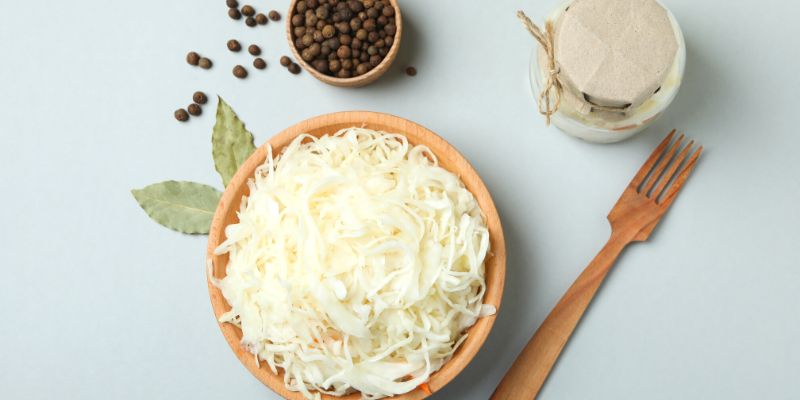
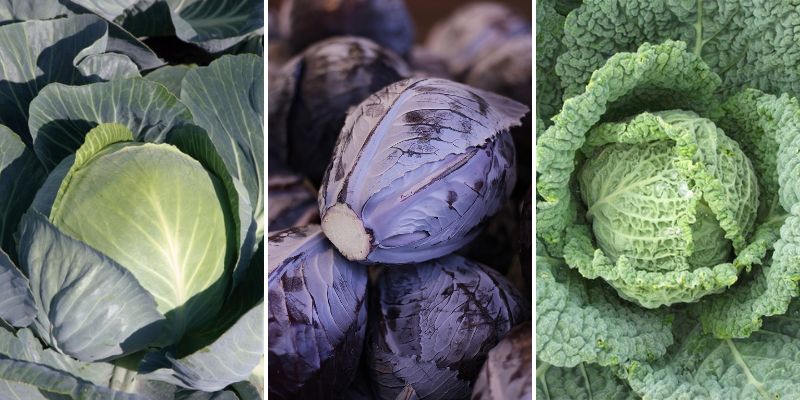
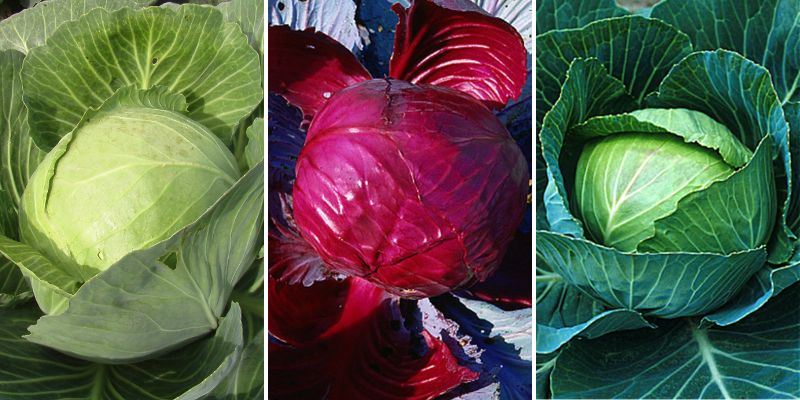
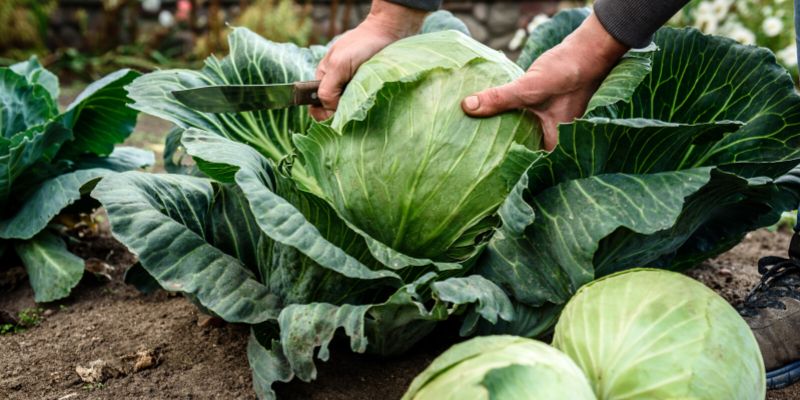
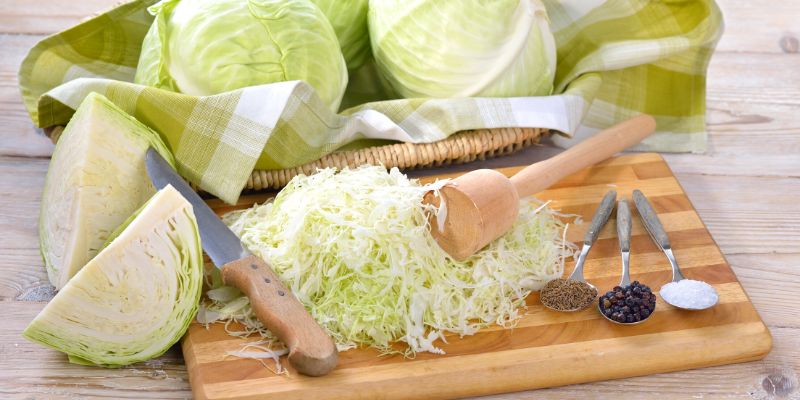
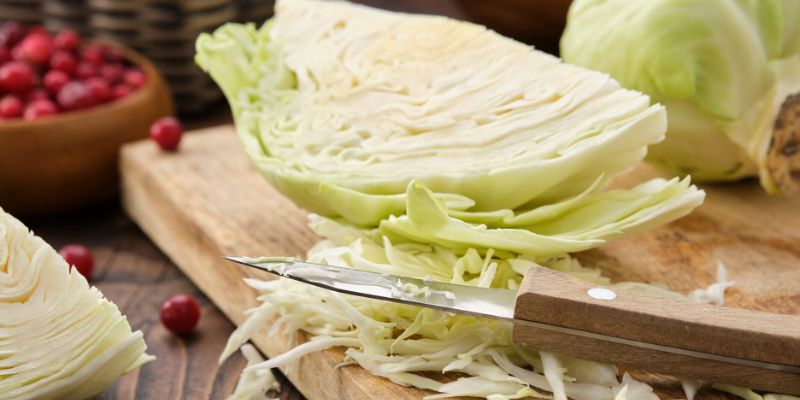
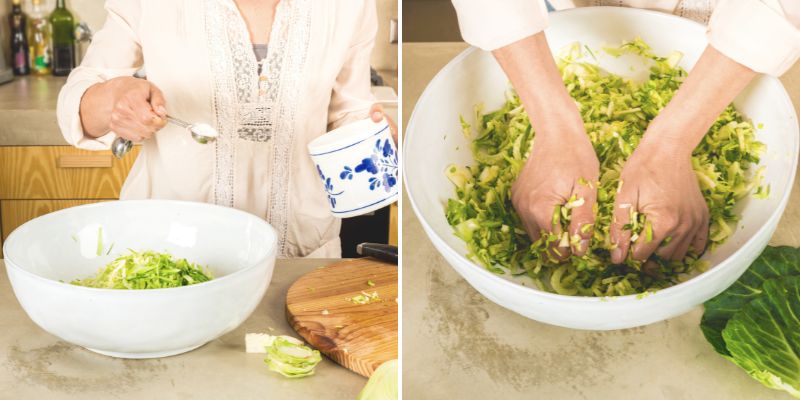
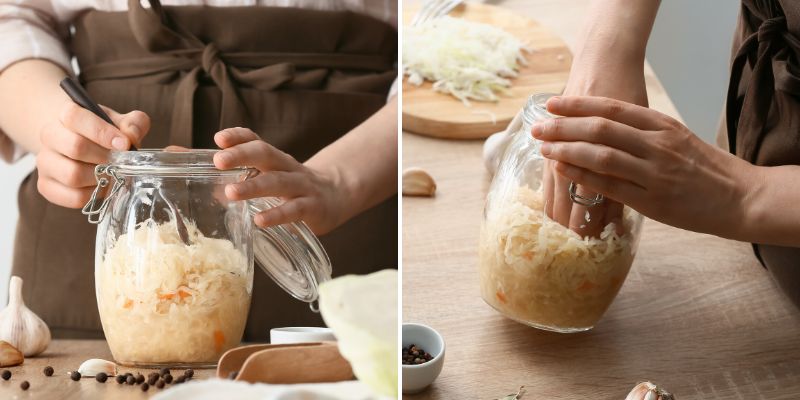
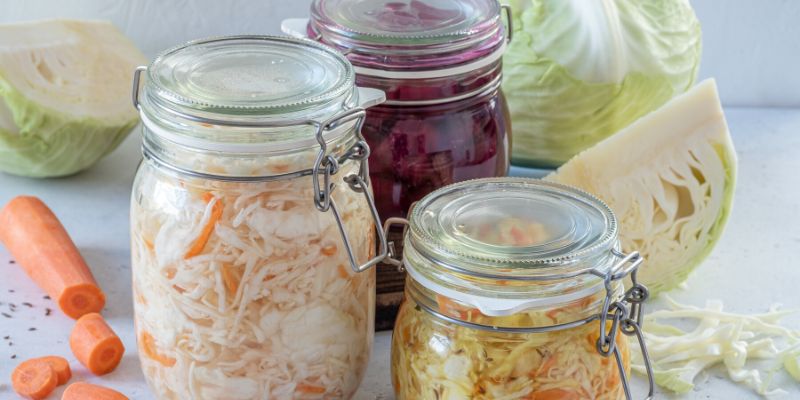

![[plant_guide id="1234" title="Cabbage"]
To make homemade {glossary} sauerkraut, start by finely shredding a {glossary} cabbage. Then, mix the shredded cabbage with salt and massage it to release the juices. Pack the cabbage tightly into a clean glass jar, making sure the cabbage is submerged in its own liquid. Place a weight on top to keep the cabbage submerged, then cover the jar with a clean cloth and secure it with a rubber band. Let it ferment at room temperature for about 3-4 weeks, checking on it periodically. Once it reaches your desired level of tanginess, transfer it to the fridge to slow down the fermentation process. Enjoy your homemade sauerkraut as a delicious and probiotic-rich addition to your meals! [recipe title="Homemade Sauerkraut"]
[ingredients]
- 1 white cabbage
- 2 tbsp {salt}
- Juniper berries
- Caraway seeds
- Bay leaves
[/ingredients]
[instructions]
1. Remove the outer leaves of the cabbage and set them aside.
2. Shred the cabbage finely.
3. In a large bowl, mix the shredded cabbage with salt, juniper berries, caraway seeds, and bay leaves.
4. Massage the mixture for about 10 minutes until the cabbage releases its juices.
5. Pack the cabbage tightly into a clean jar, pressing it down to submerge it in its own liquid.
6. Cover the cabbage with the reserved outer leaves.
7. Place a weight on top to keep the cabbage submerged.
8. Cover the jar with a clean cloth and secure it with a rubber band.
9. Let it ferment at room temperature for about 3-4 weeks, checking regularly.
10. Once fermented to your liking, store in the fridge.
Enjoy your homemade sauerkraut!
[/instructions]
[/recipe]](https://en.promessedefleurs.eu/blogwp/wp-content/uploads/2023/01/Comment-faire-de-la-choucroute-maison-.png)
Comments